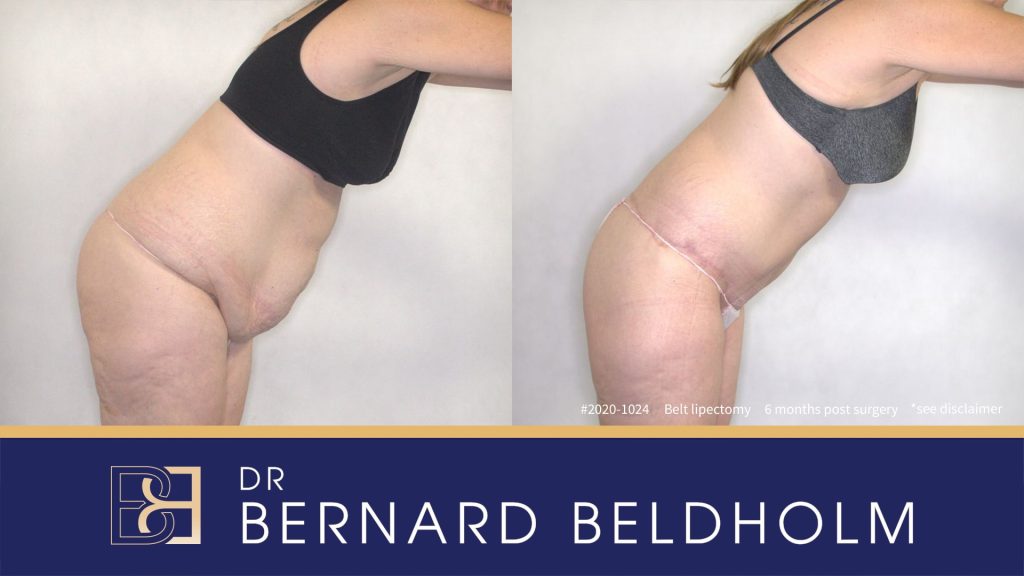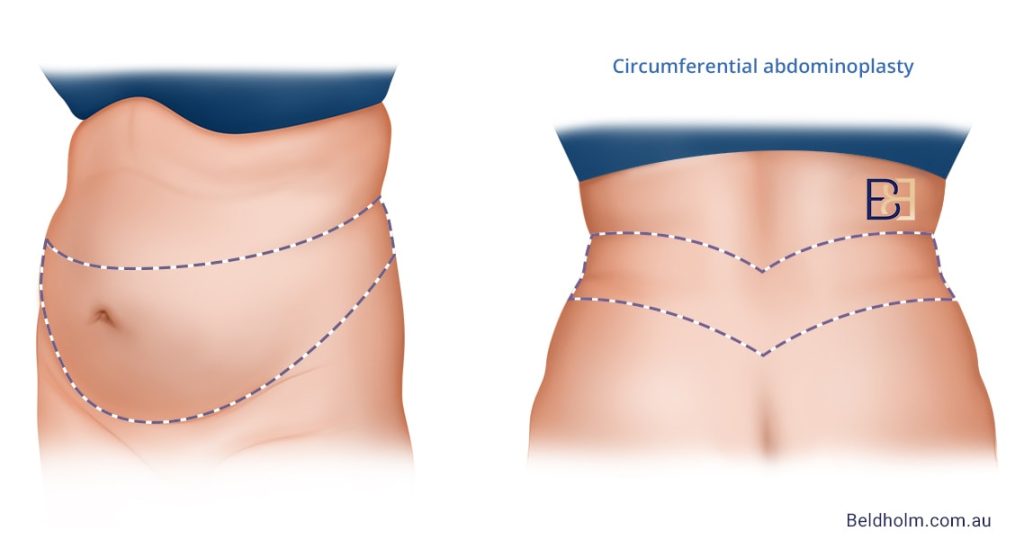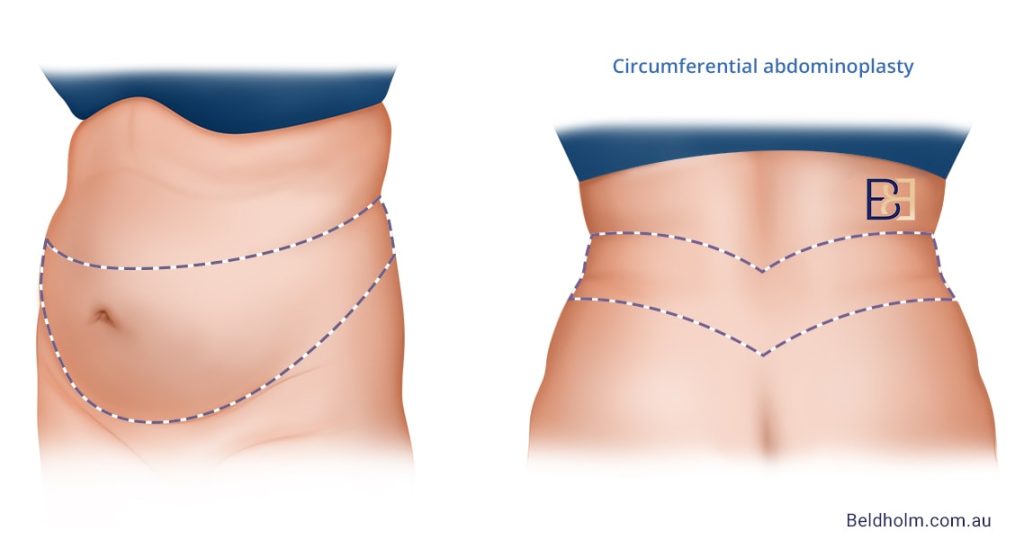Belt Lipectomy (Lower Body Lift Surgery) After Bariatric Surgery: A Comprehensive Guide
A belt lipectomy (lower body lift, 360 degrees abdominoplasty) removes excess skin from the abdomen, hips, thighs, and buttocks after significant weight loss, such as post-bariatric surgery.
Bariatric surgery can be life-changing for those struggling with obesity, often resulting in significant weight loss that impact health mobility. This is where a belt lipectomy, also known as a lower body lift, can be a next step.
A belt lipectomy is a specialised body contouring procedure designed to remove excess skin and reshape the lower body, targeting the abdomen, hips, lower back, and buttocks. In this comprehensive guide, we’ll explore the ins and outs of belt lipectomy after bariatric surgery, including what to expect from the procedure, benefits, recovery, and tips for long-term results. Whether you’re considering a lower Belt lipectomy, this article will help you make an informed decision on your path to a better you.

- Belt lipectomy performed by Dr Bernard Beldholm
Disclaimer: Operation performed by Dr Bernard Beldholm. Adult content, surgery has risks; individual results vary, seek 2nd opinion. Please see the full disclaimer.
Bariatric Surgery and its Impact on Weight Loss
In 2023, more than 15,000 Australians underwent bariatric procedures to lose weight. (Ref 2) While significant weight loss undoubtedly makes a person feel good, there is often an undesired side effect. Loose skin is a common issue after losing weight and it can negatively affect a person’s life. Many post-bariatric patients consider undergoing surgery to achieve firmer, new body contours. A lower body lift (belt lipectomy) is a major surgery that removes large skin folds around the waistline. It is a major operation and can affect skin firmness on several body areas at once.
Common Post-Bariatric Challenges
Loose skin presents unique challenges for post-bariatric patients. First and foremost, many people who’ve lost a substantial amount of weight say their skin takes a profound toll on how they feel about themselves. (Ref 1) Hygiene issues have also been reported since it can be challenging to wash between skin folds where odour-causing bacteria thrive. (Ref 1)
Excessive skin can also adversely affect a person’s physical appearance and health. Skin irritations such as rashes and chafing can become chronic problems. Folds of hanging skin can also weigh a person down or, in severe cases, restrict mobility. Additionally, it can be difficult to find well-fitting clothes when rolls of skin are in the way.
The problem is excessive skin rarely tightens on its own after major weight loss. Once the skin has stretched beyond its capacity due to extreme weight fluctuations, it permanently loses elasticity. As a result, many post-bariatric patients elect to undergo body contouring surgery to correct loose skin and achieve a toned body contour.
Belt Lipectomy (Body Lift Surgery) as a Solution
A belt lipectomy (also called body lift surgery, 360 body lift, circumferential body lift, or circumferential abdominoplasty) tightens skin on areas like the abdomen, upper pubic area, hips, lower back, buttocks, and thighs – all in one or two surgeries.

- Belt lipectomy illustration | Dr Bernard Beldholm
This surgical procedure is specifically designed for people who have lost weight after a bariatric procedure. Tightening loose skin and reducing skin folds could make it easier to perform daily activities, feel more content with your reflection in the mirror, and reduce skin irritation and hygiene issues caused by lax skin.
What is a Belt Lipectomy (Body Lift Surgery)?
Definition and Explanation of the Procedure
A belt lipectomy operation removes excess skin 360 degrees around the waist to create tighter, firmer contours after major weight loss. A circular incision is made around the waistline. Then, through the cut, the surgeon trims the excess tissue off and then pulls the remaining skin toward the waistline incision, almost like pulling up a pair of trousers.
Areas Targeted by Lower Body Lifting Surgery
A belt lipectomy (lower body lift) corrects several body areas at once. As the surgeon pulls the skin flaps together to close the incision, laxity on the abdomen, mons pubic area, flanks, lower back, thighs, and buttocks smooths out.
Overview of the Goals of the Procedure
Firmer-looking skin and a toned midsection are achievable with a belt lipectomy since it removes excess skin from key areas like the tummy, hips, thighs, mons pubis, lower back, and buttocks. These are some of the main zones where excess skin is present for massive-weight-loss patients since changes in body fat distribution tend to affect skin elasticity in these areas.

- Belt lipectomy surgery
Belt Lipectomy (Lower Body Lift) Surgery
Belt Lipectomy Pre-Operative Consultation and Planning
Evaluation by a Specialist Surgeon
In Australia, patients first need to meet with their GP to be referred to a specialist surgeon who offers body contouring. For the highest chance of a great surgical outcome, be sure to choose an experienced, licensed surgeon focused specifically on excess skin removal after extreme weight loss.
Discussing Patient Goals and Expectations

- Dr Bernard Beldholm
Your specialist surgeon will ask what body areas you want to target and examine your body for excess skin secondary to weight loss. Your consultation should include a discussion of your body contouring goals, lifestyle, amount of weight lost, medical history, and more.
If you are a candidate for a belt lipectomy, you will receive a personalised surgical plan as well as information about how to prepare for surgery and what to expect during the recovery process. You will also receive information about how much the procedure costs.
Realistic goals and expectations are a must. A belt lipectomy will not solve issues like body dysmorphia or clinical depression. It’s also not a weight-loss procedure; You will already need to be at or near a healthy weight. Your surgeon should also discuss the realities of living with a surgical scar around your waistline. The scar can take over a year to fade and isn’t guaranteed to fade completely.
Finally, your surgeon should disclose the possible risks of belt lipectomy surgery. All invasive surgical procedures carry risks like infection, poorly healed scars, lasting numbness in the treated area, and so on.
Description of the Belt Lipectomy Surgical Process
Anaesthesia and Duration of Surgery
Belt lipectomy operations typically take at least six hours to perform. You will receive general anaesthetic beforehand.
Techniques Used in a Lower Body Lift
Belt lipectomy surgery usually starts with the patient lying in the Supine position (face up). An incision is made across the lower back nearest the waistline. The excess skin is trimmed off and the incision lines are closed with sutures. The remaining skin is pulled smooth, eliminating lower back rolls and tightening the skin on the rear thighs and buttocks.
Next, the patient is turned over to the prone position (face down) and the process is repeated with an incision across the lower abdomen and hips. Closing this incision pulls the skin taut to create a smoother, firmer abdominal contour, mons pubic area, hips, and thighs. Those with severe thigh or mons pubic laxity may need a second procedure six months later for added refinement in these areas.
Belt Lipectomy Recovery Process and Timeline
The belt lipectomy recovery process takes time.
- Hospital Stay: 2-4 days
- Take a Full Shower: 4-6 days
- Return to Work/Driving 2-3 weeks (longer if you have a physically active job)
- Resume Full Exercise: 6-8 weeks
- Numbness/Swelling Subsides: 3 months
- Final Results: 12 to 24 months
- Scar Maturation: 12-18 months
Hospital Stay and Initial Recovery
After a belt lipectomy, most patients stay in the hospital for 2 to 4 days. Expect at least two to three weeks of downtime during which you will be able to walk but you won’t be able to work or drive.
Downtime may be longer for those with physically active careers or those who have a surgical complication. Bruising, soreness, changes in skin sensation, and a significant amount of swelling are common early on before eventually resolving. Physical exertion (including heavy lifting, exercise, and stressful activities) is restricted during the first six to eight weeks.
Follow-Up Appointments and Long-Term Care
After the initial recovery period, most patients are well enough to get back to their normal routine. You will need to see your surgeon regularly for follow-up visits so they can evaluate your healing progress. Although most of the post-op swelling resolves after three months, it can take a full year to see your final belt lipectomy results. To keep your body looking tight and firm for as long as possible, maintain a stable weight with a healthy lifestyle including exercise and a nutritious diet. A future pregnancy, ageing, or dramatic weight changes can diminish skin elasticity.
Belt Lipectomy (Lower Body Lift) Risks and Considerations
Common Risks Associated with the Procedure
Infection, Scarring, and Anesthesia-Related Risks
Extensive surgery like a belt lipectomy carries risks. The most common risks are usually minor or cosmetic, while life-threatening risks are rare. Your surgeon should discuss the possible complications with you before you decide to go ahead with the surgery.
Some risks to be aware of include possible breathing or heart problems related to general anaesthesia, undesirable surgical scarring, blood clots, and infections. You can lower the chance of a complication by carefully following your surgeon’s orders before and after surgery.
Importance of Choosing a Qualified, Experienced Surgeon
Removing excess skin after weight loss is a highly specialised field of surgery. It takes years of practical experience to hone the skills needed to judge how much skin to remove and how to dissect the tissues without damaging other structures.
When selecting a surgeon, it’s a good idea to read reviews, ask to see photos of their before-and-after belt lipectomy results, and ask about their credentials. It can never hurt to get a second opinion; You aren’t obligated to work with the first surgeon you see for a consultation.
Belt Lipectomy (Lower Body Lift) Cost & Private Health Insurance Considerations

- Belt lipectomy cost
Average Cost of the Procedure
Belt lipectomy operations are personalised to each patient. Therefore, the cost for a Belt lipectomy can vary significantly. The only reliable way to obtain a price quote is to meet with a specialist surgeon for an initial consultation.
Factors Influencing the Cost
Surgeons typically charge rates commensurate with their experience and credentials. Hospital and anaesthetist fees are usually billed separately. The length of your hospital stay, aftercare, medical providers, and hospital day rates can all impact pricing. The surgery can, and often is, paired with related services such as liposuction, which could affect pricing.
Insurance Coverage for a Belt Lipectomy
In Australia, belt lipectomy patients may be able utilise Medicare and/or private health coverage to lower out-of-pocket costs. Keep in mind you will likely pay the difference between the amount your health plan covers and what the surgery, hospital, and anaesthetist fees actually cost. To qualify, you must be enrolled in a participating health plan and your belt lipectomy must be done for documented, medically necessary reasons.
Preparing for Belt Lipectomy (Lower Body Lift) Surgery
Tips on Preparing Mentally
Most patients feel nervous and excited in the weeks leading up to a belt lipectomy. Speaking to your surgeon, a counsellor, friends, or family can help to allay any fears or concerns you might be experiencing.
Meditating, journaling, reading, chatting with loved ones, and getting fresh air are all great ways to reduce stress before and after a major operation. You should also mentally prepare to have some discomfort during the first few weeks of recovery.
Importance of Following Pre-Operative Instructions
Your surgeon will provide instructions in the days and weeks leading up to your belt lipectomy. You will need to avoid smoking and specific dietary supplements, vitamins, and medications. You may need to have lab work done before your operation. Adhering to your pre-operative instructions paves the way for surgery and recovery.
Support Systems: Engaging Family and Friends for Post-op Care
You should plan approximately two to three weeks off work, driving, and childcare duties. Friends and family should be prepared to help out, whether it is preparing meals, doing laundry, cleaning, shopping, or driving you to your doctor appointments. Patients without live-in support systems may benefit from hiring an aide or healthcare worker to assist them with everyday tasks for at least a week after being discharged from the hospital.
FAQs
Does a belt lipectomy(lower body lift) include muscle repair (Diastasis recti)?
This procedure can include abdominal muscle repair (Diastasis recti repair) in addition to removing redundant skin.
When is it okay to resume normal activities after a belt lipectomy?
The initial healing process lasts several weeks. Most patients are back to the office and driving within two to three weeks. Full exercise is usually ok after six to eight weeks. Heed your surgeon’s advice to promote healing and avoid damaging the underlying tissues as you heal.
Is it possible to tighten skin without a surgical or invasive procedure?
Bariatric patients with redundant skin and fat typically need an invasive surgical procedure to correct laxity. Non-surgical options such as OTC firming creams and laser therapy are not enough to correct moderate-to-severe laxity.
What other skin tightening procedures are available to post-bariatric patients?
Your surgeon may discuss other procedures such as liposuction, arm lift surgery (brachioplasty), a tummy tuck (abdominoplasty), a buttock lift (gluteoplasty), a thigh lift surgery (thighplasty), or a breast lift (mastopexy) depending on where you have laxity.
What body zones do lower body lifts (belt lipectomy)?
Belt lipectomies correct laxity on the abdomen, flanks, upper buttocks, outer upper thighs (also known as the lateral thighs), inner thighs, and mons pubic area.
Is temporary numbness common after a belt lipectomy?
It is normal to have temporarily reduced skin sensation in areas where the tissues were dissected. In the case of circumferential body lift procedures, numbness typically subsides after three months.
Is it better to undergo a thigh lift (Thighplasty) before or after a belt lipectomy?
A thigh lift (thighplasty) should ideally be performed after a belt lipectomy. Since a belt lipectomy tightens the thighs, a thighplasty could be unnecessary in some cases.
Will a Belt lipectomy remove excess skin and fat?
A belt lipectomy (full body lift) removes excess skin and fat that lies immediately under the skin. It often includes liposuction to further reduces excess fat. Body contouring surgery does not remove visceral fat around the organs, however. If you have a long way to complete your weight loss journey, you should wait until you are closer to your ideal weigh. A Belt lipectomy is not a weight-loss solution.
Is a compression garment recommended after a Belt lipectomy?
Your surgeon will most likely have you wear a compression garment for several weeks after the procedure. Although the jury is still out regarding whether compression garments aid in wound healing, most surgeons err on the side of caution and suggest wearing a post-operative garment.
What complications can occur after a belt lipectomy?
Risks such as blood clotting, anaesthesia complications, cosmetic asymmetry, and infections are possible, even for those in good health. Smoking and engaging in intense physical activities too soon can impair healing and slow recovery time.
How big is a belt lipectomy scar?
The surgical scar is usually positioned around the entire circumference of the waist. If you have concerns about scarring, ask your surgeon about their planned incision sites beforehand.
Final Thoughts

Whether you’ve lost a substantial amount of weight recently or years ago, any excess skin left behind could be an unwanted reminder of your past weight. Excessive loose skin around your waistline can hamper your functionality and disguise your weight loss results. The good news is that there’s a solution. If you are physically healthy and have realistic expectations, a body contouring operation such as a belt lipectomy could be the answer.
Although there are many factors to consider, such as a permanent surgical scar, costs, and the possible risks all surgeries involve, many body contouring patients find that tightening loose skin after extreme weight loss has had an overall positive impact on their appearance and daily life. (Ref 1)
References
- Alzahrani, Khalid J, et al. “A Psychosocial Analysis of the Effect of Body-Contouring Surgery on Patients after Weight Loss.” Eplasty, U.S. National Library of Medicine, 28 Mar. 2017, www.ncbi.nlm.nih.gov/pmc/articles/PMC5372753/.
- Bariatric Surgery Registry, www.monash.edu/__data/assets/pdf_file/0004/2582131/2021-Bariatric-Surgery-Registry_8th-Annual-Report_Amended_May.pdf. Accessed 2 Oct. 2024.


